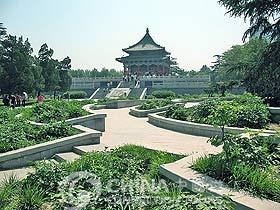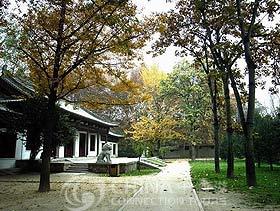The Xingqing Palace Park is situated on the eastern outskirts of the ancient city of Xi'an. It was built on the former site of the Xingqing Palace of the Tang Dynasty.
 The site proper, initially formed one part of Longqing Fang (Fang refers to the living quarters ) in the city of Chang'an. It also served as the official residence of Li Longji when he was made the crown prince. Later he became the Tang-Dynasty Emperor Xuan Zong. His former residence was reconstructed into a palace named Longqing Palace two years after he succeeded to the throne (712 AD). Before long, the Longqing Palace was renamed Xingqing Palace, to avoid using the same character "Long" as in the emperor's name. Extension work on the palace was undertaken once again in later years. As a result, parts of the neighboring Fang, such as Yongjia, Daozheng, Xing'an and Shengye were successively absorbed by the palace. Emperor Xuan Zong began to administer state affairs here in 728 AD, and the palace consequently became the center of feudal dominations in the Tang Dynasty. In the year 753 AD. it was completed with its surrounding walls. Xingqing Palace, Taiji Palace and Daming Palace were then known as the "three interior palaces".
The site proper, initially formed one part of Longqing Fang (Fang refers to the living quarters ) in the city of Chang'an. It also served as the official residence of Li Longji when he was made the crown prince. Later he became the Tang-Dynasty Emperor Xuan Zong. His former residence was reconstructed into a palace named Longqing Palace two years after he succeeded to the throne (712 AD). Before long, the Longqing Palace was renamed Xingqing Palace, to avoid using the same character "Long" as in the emperor's name. Extension work on the palace was undertaken once again in later years. As a result, parts of the neighboring Fang, such as Yongjia, Daozheng, Xing'an and Shengye were successively absorbed by the palace. Emperor Xuan Zong began to administer state affairs here in 728 AD, and the palace consequently became the center of feudal dominations in the Tang Dynasty. In the year 753 AD. it was completed with its surrounding walls. Xingqing Palace, Taiji Palace and Daming Palace were then known as the "three interior palaces".
 During the reign of Tianbao in the Tang Dynasty, the state became prosperous. The palace was rebuilt, all the more luxurious, and the gardens were tastefully planed. In the light of historical records, Emperor Xuan Zong once granted an interview to Persian Nestorian priests and Japanese friends at Xingqing Palace. After An-Shi Rebellion (the rebellion was headed by An Lushan and Shi Siming, treacherous court officials; hence the name), Xingqing Palace lost its importance in politics and became a palace where Emperor Xuan Zong lived after his abdication. The halls and buildings in Xingqing Palace were almost totally destroyed through the chaos caused by war in the late Tang Dynasty and remained in ruins up to the beginning of the Ming Dynasty.
During the reign of Tianbao in the Tang Dynasty, the state became prosperous. The palace was rebuilt, all the more luxurious, and the gardens were tastefully planed. In the light of historical records, Emperor Xuan Zong once granted an interview to Persian Nestorian priests and Japanese friends at Xingqing Palace. After An-Shi Rebellion (the rebellion was headed by An Lushan and Shi Siming, treacherous court officials; hence the name), Xingqing Palace lost its importance in politics and became a palace where Emperor Xuan Zong lived after his abdication. The halls and buildings in Xingqing Palace were almost totally destroyed through the chaos caused by war in the late Tang Dynasty and remained in ruins up to the beginning of the Ming Dynasty.
In 1957, in order to meet the recreational needs of the broad masses, the Municipal Government of Xi'an decided to build Xingqing Park on the site of Xingqing Palace of the Tang Dynasty.
The park now covers a total area of 50 hectares. The dark blue water ripples in the lake; the ground is tastefully decorated with verdant trees, blooming flowers and carpets of green lawns. The scenery in the park looks quite elegant and delightful. All the buildings such as Chengxiang Pavilion, the Flower Shedding Brilliance Gallery, Nanxun Hall, Dragon-tying Hall and Changqing Hall were reconstructed on their original sites in the architectural style of the Tang Dynasty, and their old names are still used.
In order to promote the Sino-Japanese friendship, a monument, in memory of a Japanese friend, Chao Heng, his Chinese name, was erected several years ago.
